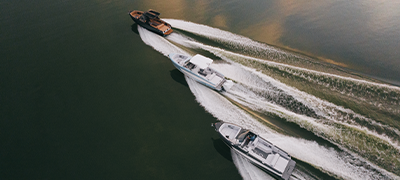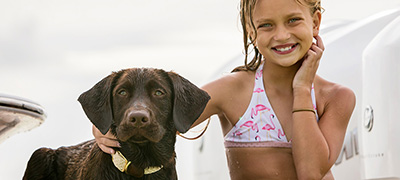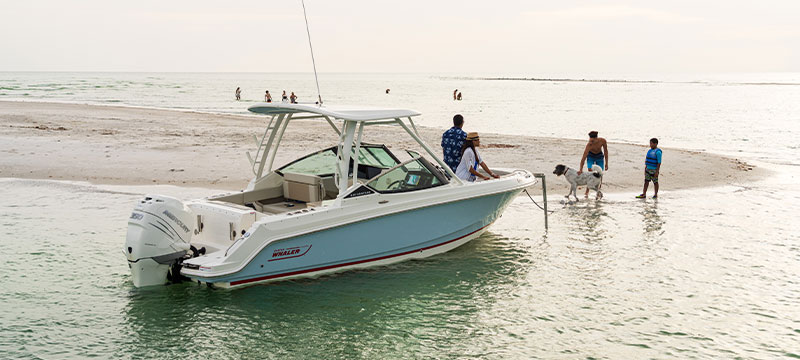How Nautical Are You?
There are many terms in boating that are not universally understood. Almost everyone knows what the bow and transom are on a boat. Most know that port is the left side of the boat when facing forward and starboard is the right side when facing forward. So why not just use left and right? The terms port and starboard reduce ambiguities when communicating with people facing different directions on a boat. In this article, some of the more obscure or abstruse terms will be explained
Sponson
Officially, it is a feature on any watercraft that extends from the hull or other part of the vessel to aid in stability while floating, or to act as a securing point for other equipment. Picture a seaplane’s pods that extend out from the fuselage or under the plane’s underside, these are sponsons. Sponsons on boats and ships can be similar. However, they are frequently used to explain hull extensions. Boston Whaler founder, Richard Fraser, who crafted the first twin sponson 13-foot Boston Whaler uses the term sponson to explain the two hull extrusions that extend from the transom to the bow on the port and starboard underside of their skiff style boats such as the Montauk models. Boston Whaler’s earliest designer, Bob Dougherty, famously brought the forward most portion of the twin sponsons into what the company called the “Whaler Smirk.” Sponsons add stability when underway or at rest. They also make turns sharper as they dig in on the inside of the turn.
Fairleads and Chocks
Fairleads and chocks are terms that are regularly misused even by experienced boaters. A fairlead is a device to guide working lines with fixed rollers around other objects onboard. A chock is designed to keep lines from moving laterally when fixed to a cleat usually when moored.
Gunwale
Pronounced “gunnel” the gunwale is the upper most edge of the boats hull. It is often the point that people board the boat before stepping into the cockpit and will often have a non-skid surface. From the waterline to the gunwale is referred to as the “freeboard” of a boats hull.
Hawse Pipe
Another misunderstood boat feature is a hawse pipe. Many boats incorporate hawse pipes in their design to avoid the hazards that exposed cleats create. In lieu of having a fixed cleat on the gunwale or transom platform the cleat is mounted out of the way underneath the gunwale with an opening in the gunwale to pass a dock line through. The opening is usually protected with stainless-steel or brass plating. The pass-through is called the hawse pipe.
Sheer
Boats are often defined by their sheer line which is the transition of the gunwale from the transom to the bow. Most boats have a graceful sheer that rises from the aft end of the boat to the bow. Some have what is referred to as a broken sheer which means the transition forward is not smooth, there is a break along the sheer. Hatteras convertible sportfishing boats are famous for their broken sheer lines where the cockpit freeboard is relatively low with a flat gunwale and rises up abruptly at the cabins superstructure and continues to rise to a wide bow flare.
Deadrise
The deadrise of a boat defines the vertical transition of the hull from the keel to the hull sides. The deadrise transitions from the bow to the transom. Often the bow has a sharp entry to slice into chop and gradually becomes less sharp as the hull transitions to the stern. Deadrise has a lot to do with how a boat will ride. Deadrise is measured throughout the length of the hull. However, manufacturers often refer to the deadrise at the transom to let potential customers understand what to expect from the boats performance. 20-degrees or more of deadrise at the transom usually defines a high-performance hull with a soft ride. The trade off is an aggressive deadrise makes a deeper hull which will not be capable of shallow water passages.
Deep-V Hull
High performance Deep-V hulls were first introduced by Raymond Hunt in the late 50s. Typically deep-V hulls have an aggressive bow entry of 40-degrees or more and a deadrise at the transom of 20-degrees or more. Dick Bertram in 1959 built a wooden model of a Hunt design with a 24-degree deadrise at the transom to be used as a plug for the now famous Bertram Mopie 31. Bertram went racing with the wooden model where it outperformed the world's top offshore raceboats finishing a day ahead of most in the grueling 1960 Miami-Nassau Race, and lived on for decades as a much-desired sportfishing boat. Fiberglass models were made into the 80’s and are still in demand today.
Chine
A boat's chine is where the hull bottom transitions into the hull’s side. Rounded chines were typical before the advent of the deep-V hull. As more manufacturers developed sporty models with adaptations of Hunt’s deep-V they discovered that at low speeds and when sitting still, the V-form created an instability when peopled moved about or in a seaway. The chines were initially above the waterline. To create more stability designers lowered the chine to just below the waterline which created a more submersed beam. The lowered chine did not effect performance as the hull raises up to plane and the chine comes out of the water. Today, deep-V hulls have “hard” or “reversed” chines. As the deadrise meets the hull side the chine is either wide and flat or wide and angled downward. This provides stability much like a sponson and provides lift while directing the wash down and away from the boat. Boston Whaler 350 Outrage is a good example of a modern deep-V hull with a 23-degree deadrise at the transom with an aggressive bow entry and hard chines creating a soft, dry ride in most offshore conditions.
Strakes
Originally strakes were the longitudinal boards that formed the hull of a wooden lap-strake boat. Modern lifting strakes are another development that improved hull performance. These longitudinal ridges in the hull run from the transom towards the bow, often to the boats stem. Strake design vary from model to model but generally help the boat get on plane quickly and in turn improve the boats straight line tracking.
Displacement Hull
Displacement and semi-displacement hulls do not come up to plane. Because of the general nature of a displacement hull, the more power applied, the more the hull is sucked downward adding more resistance. Displacement hulls are designed to push through water with less demand on propulsion often making them more efficient. The amount of water pushed aside equals the mass of the boat, thus displacement. As a very general rule the maximum speed of any displacement hull, more commonly called its hull speed, is governed by a simple formula: hull speed in knots equals 1.34 times the square root of the waterline length in feet. Semi-displacement hulls break this rule with a modified hull design that remains efficient at typical full displacement speeds but as power is added can exceed displacement speeds but never actually plane. The higher speeds are typically very inefficient, but come in handy when avoiding weather or arriving at a destination on schedule.
Rules of the Road
Rules of the road are the Navigation Rules for vessels to establish corrective actions for boaters to take to avoid a collision. The Navigation Rules are published by the U. S. Government Printing Office, and are available in most boating supply stores. All boat owners should have a copy, but it is mandatory that a copy be kept aboard all vessels over 12 meters (39.4 feet) in length. The International Regulations for Preventing Collisions at Sea 1972 (COLREGs) are published by the International Maritime Organization (IMO) and set out, among other things, the "rules of the road" or navigation rules to be followed by ships and other vessels at sea to prevent collisions between two or more vessels. These are available at most boating supply stores as well. Both describe when two or more vessels are in a “give way” (burdened) situation or a “stand on” (privileged) situation. As an example, a boat approaching in the starboard bow quarter is the stand on vessel. The boat it is approaching is in the give way position. Another example is a boat that wants to pass another boat is in the give way position and the boat being passed is the stand on position.
Wheelhouse
The wheelhouse of a boat is literally the sheltered area where steering wheel is located, either at the inside helm station or the bridge of the boat. Wheelhouse has become an expression meaning within a persons general knowledge and that person is advantageously at ease. As in “… as the questions become less hypothetical and more about simple math he should be in his wheelhouse.”
Winch and Windlass
A winch and a windlass are often confused because they pretty much serve the same purpose, to move heavy object more easily. Generally a winch is a deck apparatus with a vertical cylinder that is either cranked or electrically actuated to raise and lower sails or control the sails sheets (the lines that bring the sail in and out). On a power boat a winch can help with handling lines and on a trailer there is often a winch to snug up the boat on the trailer. A windlass is a device for raising heavy weights. On a boat the windlass is for raising and lowering the ground tackle which is the anchor and rhode (chain and line attached to the anchor).
Yacht
The meaning of the term yacht is highly debated. Some think it is a boat of over 40-feet. Merriam-Webster defines it as any of various recreational watercraft: such as a : a sailboat used for racing or b : a large usually motor-driven craft used for pleasure cruising. In general a yacht has to have three features to qualify for the designation. A place to sleep, a galley and a head.
Yar
Pronounced “yar” the word is most often associated with being in excellent condition for the mission at hand. Merriam-Webster defines yar as set for action : ready or yar play a : characterized by speed and agility : nimble, lively b : handy c : maneuverable. It is a bit antiquated as a term but someone may, upon seeing a particularly well appointed full displacement yacht with a sensuous sheer and gunwale running along the forward wheelhouse and bow mounted heavy duty windlass, say “my, that boat sure is yar.”

Boat Types

The Boating Lifestyles Blog

